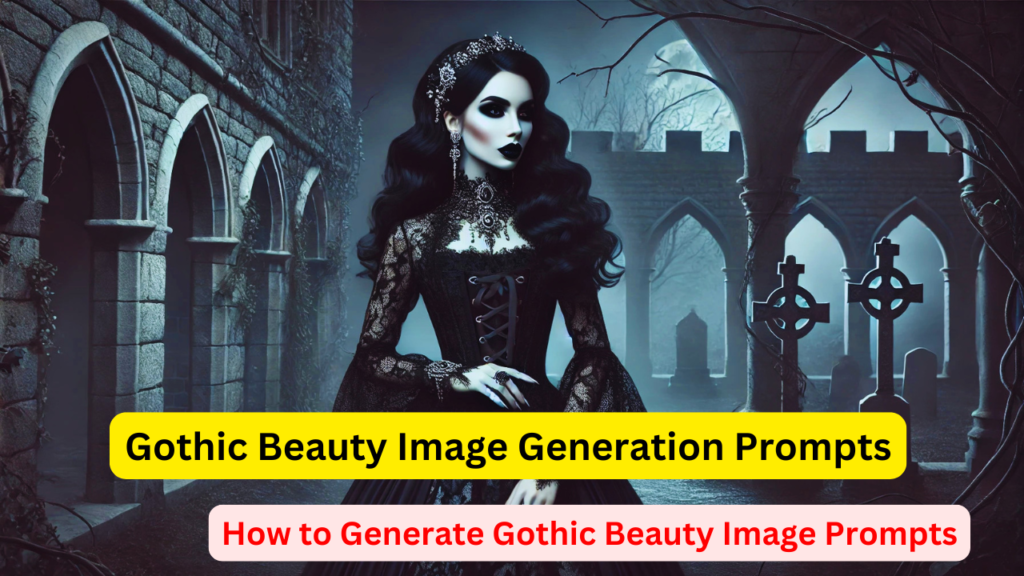Gothic beauty, characterized by its dark elegance, moody atmospheres, and dramatic elements, has captivated artists and audiences alike for centuries. With the rise of AI image generation, capturing the essence of this aesthetic has never been more accessible. But what exactly defines “Gothic beauty,” and how can you harness AI to create visually stunning art?
Gothic beauty often combines elements of mystery, darkness, and romance. From eerie landscapes to intricate fashion and hauntingly beautiful faces, this art form speaks to those who appreciate a blend of the macabre and the elegant. When combined with AI, these characteristics can be vividly brought to life through carefully crafted prompts.
Understanding Gothic Aesthetics
Key Elements of Gothic Beauty
To effectively generate images that embody Gothic beauty, it’s essential to understand its core elements:
- Dark Color Palettes: Black, deep reds, purples, and blues dominate the scene.
- Intricate Details: Lace, ornate designs, and rich textures.
- Dramatic Lighting: High contrast with sharp shadows, evoking a sense of mystery.
- Symbolism: Common Gothic symbols include skulls, ravens, and crosses.
Historical Influence on Modern Gothic Art
Gothic beauty draws from a rich history that spans from medieval architecture to Victorian fashion. The influence of these eras is evident in the modern interpretations of Gothic art seen in films, fashion, and digital illustrations.
The Role of AI in Gothic Beauty Image Generation
Evolution of AI in Art
AI has transformed how artists create, offering new tools to bring imaginative visions to life. Models like DALL-E, Midjourney, and Stable Diffusion allow users to input descriptive prompts and generate images that align with their creative vision.
AI Models Best Suited for Gothic Image Generation
- Midjourney: Known for its artistic and stylized outputs, perfect for Gothic themes.
- DALL-E: Offers diverse interpretations and detailed outputs.
- Stable Diffusion: Great for high-resolution, realistic depictions.
Crafting the Perfect Gothic Beauty Prompts
Understanding the Power of Prompts
Prompts are the bridge between your vision and the AI’s output. A well-crafted prompt should be descriptive yet focused, capturing the key elements of Gothic beauty you wish to see.
Key Tips for Effective Prompt Crafting
- Be Specific: Describe not just what you want to see, but how you want it to feel.
- Use Descriptive Adjectives: Words like “ethereal,” “ominous,” “decaying,” and “opulent” can add depth.
- Incorporate Symbols: Mention Gothic elements like “foggy graveyards” or “moonlit castles.”
Gothic Beauty Image Generation Prompts : “A stunning Gothic beauty standing in a dark, mysterious setting. She has long, flowing raven-black hair adorned with delicate lace and intricate silver jewelry. Her skin is porcelain pale, contrasting sharply with her deep, dark lipstick and smoky eye makeup. She’s dressed in a flowing, elegant black lace gown with Victorian-era details, including corset lacing and a high collar. The background features a dimly lit, ancient stone castle with arched windows and creeping ivy. The atmosphere is eerie yet beautiful, with a full moon casting a ghostly glow over the scene.”
Prompt Ideas for Gothic Beauty Image Generation
Dark Elegance and Mysterious Vibes
- “A hauntingly beautiful woman with pale skin, dressed in Victorian black lace, standing in a misty forest.”
- “A Gothic castle shrouded in fog, with eerie green lighting and gargoyles.”
Victorian and Medieval Gothic Elements
- “A knight in dark armor, with a cracked helmet, standing against a blood-red sky.”
- “An ancient cathedral with stained glass windows glowing faintly under the moonlight.”
Gothic Fashion and Makeup Prompts
- “A model with smokey eye makeup, black lipstick, and elaborate Gothic jewelry.”
- “A figure in a flowing black gown with silver embroidery, set against a stormy backdrop.”
Haunted Mansions and Moody Landscapes
- “A dilapidated mansion on a hill, surrounded by dead trees and illuminated by a single lightning bolt.”
- “A twisted, ancient forest with thick fog and dark, looming branches.”
Enhancing Image Outputs with Detailed Prompts
Using Specific Descriptive Words
Using words like “decaying,” “ethereal,” and “shadowy” helps the AI understand the mood and tone you wish to convey.
Incorporating Gothic Symbols and Motifs
Adding elements like “crows,” “full moons,” or “antique candle holders” can bring a Gothic touch to the generated images.
Visual Storytelling in Gothic Art
Creating Narratives Through Images
Crafting prompts that tell a story can make your Gothic art more compelling. For instance:
- “A lone figure standing on a cliff, staring out at a stormy sea, with ravens circling overhead.”
Example Prompts for Story-Driven Gothic Art
- “An abandoned ballroom, with a ghostly figure dancing alone under a shattered chandelier.”
Common Mistakes to Avoid in Prompt Creation
Overloading Descriptions
While detail is important, too many descriptors can confuse the AI. Stick to three to four key visual elements.
Lack of Coherent Themes
Make sure your prompts maintain a clear theme. Mixing too many elements can result in chaotic, unfocused images.
Advanced Techniques for Gothic Image Prompts
Layering Themes and Styles
Combine Gothic aesthetics with other styles, like “cyberpunk Gothic” or “steampunk Gothic,” to create unique visuals.
Combining Gothic with Other Aesthetic Elements
Try blending Gothic themes with elements like “ethereal fantasy” or “dark sci-fi” for a more personalized touch.
Customizing Prompts for Personal Projects
Personalizing for Unique Art Styles
Adjust prompts to fit your unique style by including specific influences, such as “inspired by Tim Burton” or “in the style of dark romanticism.”
Balancing Creativity with Prompt Constraints
Experiment with your prompts while keeping them concise enough to guide the AI clearly.

